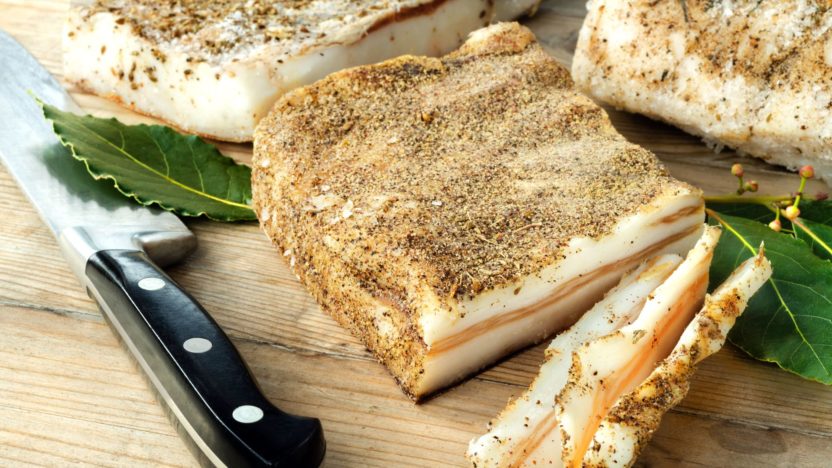 IGP
Toscana
IGP
Toscana
Colonnad edlade
The Colonnade Lardo is a Protected Geographical Indication (IGP) on the national list approved by the Ministry of Agriculture And Forestry, whose requirements are regulated by the production discipline of the Tuscany Region.
Features
At the time of consumption, the Column Edardo has the following characteristics:
– Shape: variable, indicatively rectangular; 3 cm thick.
– External aspect: the lower part retains the rind while the upper part is covered by the seasoning salt made dark by aromatic plants and spices; there may be a skinny strip.
Overall the product appears moist, of homogeneous and soft consistency, white, slightly pinkish or vaguely burnished.
– Perfume: fragrant and rich in aromas.
– Taste: delicate and fresh taste, almost sweet, finely savory if coming from the buttocks area, enriched by herbs and spices used in processing.
Production
The Colonnade Lard is obtained from the cuts of meat corresponding to the fatty layer (cleaned from the sugnosa part) that covers the back from the occipital region to the buttocks and that laterally reaches up to the bacon. The thickness must be more than 3 cm.
The ingredients for processing and seasoning the product are: natural sea salt, ground black pepper, fresh rosemary, garlic peeled and roughly chopped. These ingredients are taxable, but in any case the producer’s discretion is to determine the quantities of the quantities.
The producer can also use other spices, whole or ground, in particular cinnamon, star anise, coriander, nutmeg and cloves and other herbs, especially sage and oregano.
It excludes lihigh-dried substances, natural, natoridentical and artificial aromas, preservatives, additives and starters.
The microclimate characteristics present in the processing area are decisive in the dynamics of the production cycle.
The processing is seasonal and takes place from September to May, including, every year. The lard must be worked fresh. Within no more than 72 hours of slaughter must be trimmed, massaged with salt and placed in the special marble tubs, locally called conche, preemptively rubbed with garlic, alternating layers of lard with the other ingredients until the filling the container. At the end of the operation, the lid will be affixed to the conca.
The basins are containers of white marble in the shape of a bathtub, made from material from the agro marble of the “Canaloni” of the Colonnata basin, which has peculiarities of composition and structure essential to the optimal aging and ripening of the product. The hollows can be obtained from the emptying of a single block of marble or from slabs no less than 2 cm thick properly assembled. As for the lid of the shells, this will be marble or other suitable material. The lard will have to rest inside the shells for a seasoning period of no less than six months.
The seasoning must take place in unaffected premises and without any forced conditioning, so as not to compromise the natural humidity of the environment. During the seasoning, the manufacturer will have to check the consistency of the CD. “salamora”, which is the liquid released by the lard as a result of prolonged contact with salt. If the lard does not form “salami” in sufficient quantities, the producer will be able to supplement the quantity of the lard with a cold solution of water saturated with sodium chloride, obtained from the dissolution of sea salt, to the extent necessary to the optimal product storage.
The product is placed on the market in slices of variable weight, from 250 to 5000 grams, vacuum-packed in plastic packaging or other suitable material or in other forms to ensure the maintenance of its sensory characteristics.
The lard can also be marketed sliced or ground and properly packaged.
Pre-dealing and grinding with subsequent packaging can only take place in the production area and should not affect the sensory characteristics of the product.
The final retailer will be able to slicing on the counter, taking care to safeguard the special non-reusable seal.


